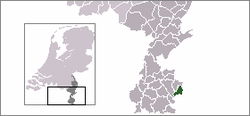- Kerkrade
-
Kerkrade
Kirchroa— Municipality — 
Flag
Coat of armsCoordinates: 50°52′N 6°04′E / 50.867°N 6.067°E Country Netherlands Province Limburg Area(2006) – Total 22.17 km2 (8.6 sq mi) – Land 21.93 km2 (8.5 sq mi) – Water 0.24 km2 (0.1 sq mi) Population (1 January 2007) – Total 48,721 – Density 2,222/km2 (5,755/sq mi) Source: CBS, Statline. Time zone CET (UTC+1) – Summer (DST) CEST (UTC+2) Kerkrade ([ˈkɛrkˌraːdə] (
 listen)) (Limburgish: Kirchroa) is a town and a municipality in the southeastern Netherlands. It is the western half of the divided region and de facto city, taken together with the eastern half, the German town of Herzogenrath. The original name of the undivided municipality under the Holy Roman Empire was Herzogenrath.
listen)) (Limburgish: Kirchroa) is a town and a municipality in the southeastern Netherlands. It is the western half of the divided region and de facto city, taken together with the eastern half, the German town of Herzogenrath. The original name of the undivided municipality under the Holy Roman Empire was Herzogenrath.Nowadays the two towns, including outlying suburban "villages", have a combined population approaching 100,000.
Contents
History
The history of Kerkrade is closely linked with that of the adjacent town of Herzogenrath, just across the German border.[1] Herzogenrath began as a settlement, called Rode, near the river Worm (or Wurm in German) in the 11th century. In 1104 Augustinian monks founded an abbey, called Kloosterrade, to the west of this settlement.
It was called 's-Hertogenrode or 's-Hertogenrade (Dutch: the Duke's Rode) after the duchy of Brabant took control over the region; in French it was called Rolduc (Rode-le-duc). As is the case for many parts of the Southern Netherlands, the place changed hands several times in the last few centuries. It was under Spanish control from 1661, Austrian between 1713 and 1785 and French between 1795 and 1813. In 1815, when the kingdom of the Netherlands was formed (see Vienna Congress), the border was drawn through Herzogenrath, the western part being Kerkrade.
In the 18th century the monks of Rolduc began small-scale coal mines. More modern exploitation by others started in 1860, causing Kerkrade to grow significantly, especially as a consequence of the permanent settlement of mainly Southern-European miners in this Northern-European place. When the Willem Sophia mine was opened around 1900, the town grew even more rapidly, absorbing old villages like Chèvremont. In the decades following 1960, all the mines in Limburg were closed.
One of the oldest buildings in the municipality is Oud Ehrenstein, a castle the origins of which lie in the 14th century.
The border along Nieuwstraat/Neustraße
One part of the border between the Netherlands and Germany runs along the middle of the street Nieuwstraat/Neustraße. Because of relatively unrestricted cross-border travel within the European Union, this border was for many years marked only with a low wall, about 30 cm high, running along the length of the street. There was a separate 2-way road on each side, and cars had to pass through the official crossing points, but pedestrians could readily step over the wall (although there were signs informing of the border). In 1995, it was decided to remove the wall completely. Nieuwstraat/Neustraße is now a single two-way road, with the extra space now occupied with trees and bicycle lanes. The border is unmarked, and is crossed even when going round a roundabout or overtaking a vehicle.
Population centres
Kerkrade's outlying neighborhoods and housing developments include:
- Eygelshoven
- Kaalheide
- Bleierheide
- Spekholzerheide
- Terwinselen
- Holz
- Rolduckerveld
- Hopel
- Chèvremont
- Haanrade
- Gracht
- Rolduc
Music
Every fourth year the World Music Contest, a competition for amateur, professional, and military bands, is held in Kerkrade.[2] Also, for the last three years, the Drum Corps Europe championships have been held here.
Natives of Kerkrade
- Wiel Coerver (born 1924)- footballer and manager
- Willy Brokamp (born 1946) – footballer
- Gerd Leers (born 1951) – politician
- Heintje Simons (born 1955) – singer
- Pierre Vermeulen (born 1956) – footballer
- René Trost (born 1965) – footballer
- Sieb Dijkstra (born 1966) – footballer
- Jörg Müller (born 1969) – race driver
- Roy Bejas (born 1987) – footballer
Transportation
There are 4 stations in Kerkrade:
- Kerkrade Centrum railway station
- Chevremont railway station
- Eygelshoven railway station
- Eygelshoven Markt railway station
There was another station, Kerkrade West or Spekholzerheide. It closed for public rail in 1988, and since 1992 it is in use by a museum-railway-company, ZLSM.
Miscellaneous information
The building of a dam in the Anstel, a brook flowing west of Kerkrade, has led to the formation of a reservoir with an area of about 20 ha. This and its surroundings are very rich in flora and fauna.
Kerkrade is the home of the football club Roda JC.
The patron saint of Kerkrade is Saint Barbara, who is also the patron saint of miners.
References
- ^ Stenvert, R. et al. (2003). Monumenten in Nederland: Limburg, p. 173–178. Zwolle: Waanders Uitgevers. ISBN 90-400-9623-6.
- ^ "World Music Contest opens in Kerkrade". Radio Netherlands Worldwide. 12 July 2009. http://www.rnw.nl/english/article/world-music-contest-opens-kerkrade. Retrieved 22 August 2011.
External links
- Official Website
- Encyclopedia on Kerkrade (Dutch) – a wiki using MediaWiki 1.52
Beek · Beesel · Bergen · Brunssum · Echt-Susteren · Eijsden-Margraten · Gennep · Gulpen-Wittem · Heerlen · Horst aan de Maas · Kerkrade · Landgraaf · Leudal · Maasgouw · Maastricht · Meerssen · Mook en Middelaar · Nederweert · Nuth · Onderbanken · Peel en Maas · Roerdalen · Roermond · Schinnen · Simpelveld · Sittard-Geleen · Stein · Vaals · Valkenburg aan de Geul · Venlo · Venray · Voerendaal · Weert Categories:
Categories:- Kerkrade
- Cities in the Netherlands
- Mining communities in the Netherlands
- Populated places in Dutch Limburg
- Divided regions
- Germany–Netherlands border crossings
Wikimedia Foundation. 2010.


